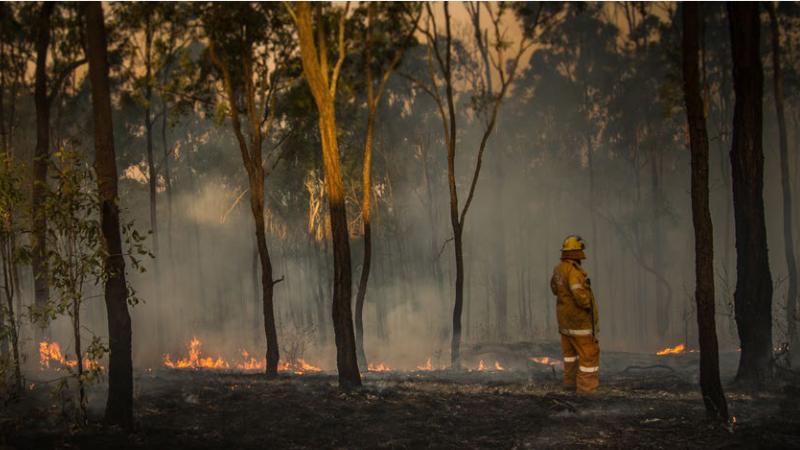The ‘National Adaption Plan’ of how to manage risks and combat climate change is high on rhetoric and short on substance. David McEwen on what could have been.
On paper, Australia’s new 76-page National Adaptation Plan (NAP) reads like a master class in good intentions—grand visions, glossy case studies and majestic statements about whole-of-society collaboration. In reality, it’s the classic “dog ate my homework” excuse: a hollow document short on substance about how to deal with the risks identified in the National Climate Risk Assessment (NCRA).
The NAP is a paperweight, not a playbook.
Rhetoric over reality
Other nations don’t hide behind broad principles. The Netherlands’ Delta Programme is enshrined in law, funded every year, and driven by centigrade-specific sea-level milestones. The UK’s Adaptation Reporting Power (enshrined in law since 2008) imposes – as independent MP Zali Steggall has also proposed – mandatory risk disclosures, annual adaptation progress reports to Parliament, and penalties for inaction.
Australia’s NAP offers…collaboration. It rarely says who pays, who acts or what happens if nothing changes. It mentions several government spending commitments, which may amount to approximately 0.2% of federal government spending.
There’s no federal fund for coastal or riverine defences. No obligation for states to assess and budget for planned relocation of exposed communities. And few teeth to enforce building-code upgrades or resilience standards.
Climate risk report is old news. Australia needs transition … to reality
Climate change doesn’t operate in a vacuum. It supercharges existing fractures—economic, social and political. Yet the NAP never once uses the phrase “threat multiplier.” It barely mentions how heatwaves, floods or fires could deepen wealth gaps, exacerbate housing stress, and fuel resentment among communities already stretched thin, for example:
- Low-income households face unaffordable electricity bills when summer temperatures spike, or risk their health by going without A/C in poorly insulated homes.
- Domestic violence surges during heatwaves, devastating families and stressing social support services.
- Renters and mortgagees struggle to rebuild after disaster with no equity buffer and increasing insurance unaffordability.
- First Nations communities see cultural sites scorched or submerged with no dedicated rebuilding grants.
Without a clear equity lens, adaptation benefits the well-resourced, leaving others to pick up the scraps and stoking unrest.
Food security, migration, societal breakdown
The NAP flags the risk of falling farm yields and rising biosecurity threats. But it stops at on-farm “resilience grants,” drought forecasts and soil-health research. While it makes several references to food security for remote communities and proposes the development of a national food security strategy, it doesn’t directly confront food scarcity or price shocks that might accompany simultaneous local and international harvest failures.
It proposes no strategic food reserves, no emergency price-support mechanism, and no plan for vulnerable households should grocery bills skyrocket. Hungry bellies foment unrest, so it’s an area that needs critical focus.
The NAP makes one passing reference to climate-induced domestic migration in one of its most prescient paragraphs:
“By 2090, ineffective responses to frequent and escalating events may lead to a breakdown of social capital and cohesion, reductions in volunteer participation, increased risk exposure in response and recovery work, and heightened tensions over climate-induced domestic migration (movement of people within Australia due to climate impacts in some communities and regions).”
Nowhere does international climate migration appear (which is explained by the myopic domestic focus of the National Climate Risk Assessment).
Imagine remote towns forced to evacuate after repeated floods, then funnelled into already-tight urban rental markets. Picture island neighbours displaced by sea-level rise arriving with few legal pathways. Without pre-emptive planning, those scenarios could unfold as flashpoints for social tension, at which point “shared responsibility” verbiage will be useless in calming the storm.
Scholars of collapsed civilisations – from the Mayan lowlands to Mesopotamian marshes – highlight that environmental stress alone doesn’t topple societies.
It’s the deadly cocktail of resource depletion, institutional failure, inequality and external shocks that breaks the social bond.
The NAP glosses over this. It suggests local mental-health grants and community hubs as panaceas, but stops well short of the contingency planning you’d need if a town’s civic fabric starts to tear. There are no trigger points for federal intervention, no escalation protocols for mass displacement, and no framework to shore up failing local services.
The missing pieces
Turning an excuse into action requires bold, operational detail, not another Polaroid of a flooded street. Here’s what the NAP could have been:
- Ring-fenced adaptation funding:
A multi-billion-dollar federal pool with clear co-investment rules for states, territories, local governments, and major emitting businesses. As the crisis deepens, we can’t afford to protect everyone, but we must provide clear guidelines to avoid maladaptation and ensure equitable decision-making. - Enforceable mandates and deadlines:
Immediate Planning changes to prevent further development in increasingly marginal locations. Assessment of limits to adaptation for natural, infrastructure and social systems. Legally binding timelines for community protections, including clear decision criteria to assess “protect and defend” vs “planned relocation” tradeoffs. Resilience upgrades to building codes. Clear accountability and consequences for non-performance. - Food-security triggers and reserves:
Start planning ahead of future shortages, including consideration of strategic commodity stockpiles, price-support mechanisms, and emergency food vouchers for low-income households based on supply or price triggers. - Equity-first framework:
Prioritised adaptation investments in First Nations lands, low-income neighbourhoods and renter-dominated regions (including minimum resilience requirements for rentals). Co-design processes to ensure local voices shape the solutions. - Migration-contingency planning:
Federal–state protocols for both internal relocation and international arrivals driven by climate displacement. Subsidised housing allocations, work-permit fast-tracks and community integration funds to head off xenophobic backlash. At some point, Australia will need to increase its contribution to global loss and damage funding; with a climate migrant plan, perhaps some of that spending could stay on-shore. - Threat-multiplier monitoring:
A dashboard tracking social-cohesion indices, inequality metrics, and mental-health indicators—tied to adaptation funding escalators whenever composite stress signals spike. - Integrated governance architecture:
A National Adaptation Commission with statutory powers, clear interagency roles, public scorecards and the authority to enforce cost-shifts when state or local bodies falter.
A deliverable blueprint
Australia boasts world-class hazard models, pioneering nature-based solutions, incredible natural and human capital assets for emissions reduction, and a thriving green-tech sector. What we lack is the political will to stitch those assets into a real, binding plan. The NAP must evolve from a collection of principles into a legislated blueprint, complete with budgets, mandates, governance, and social equity baked in.
Otherwise, we’re handing future parliaments the same old excuse. And let’s face it: no one buys the “dog ate my homework” story after the twentieth climate-driven disaster.
It’s time for a plan that bites back.
David McEwen is a Director at Adaptive Capability, providing climate risk and emissions reduction strategy, program and project management. He works with businesses, community leaders, policy makers, designers and engineers to deliver impactful change. His book, Navigating the Adaptive Economy, was released in 2016. He holds an MBA from the Australian Graduate School of Management and a certificate in Sustainability and Climate Risk from the Global Association of Risk Professionals.

